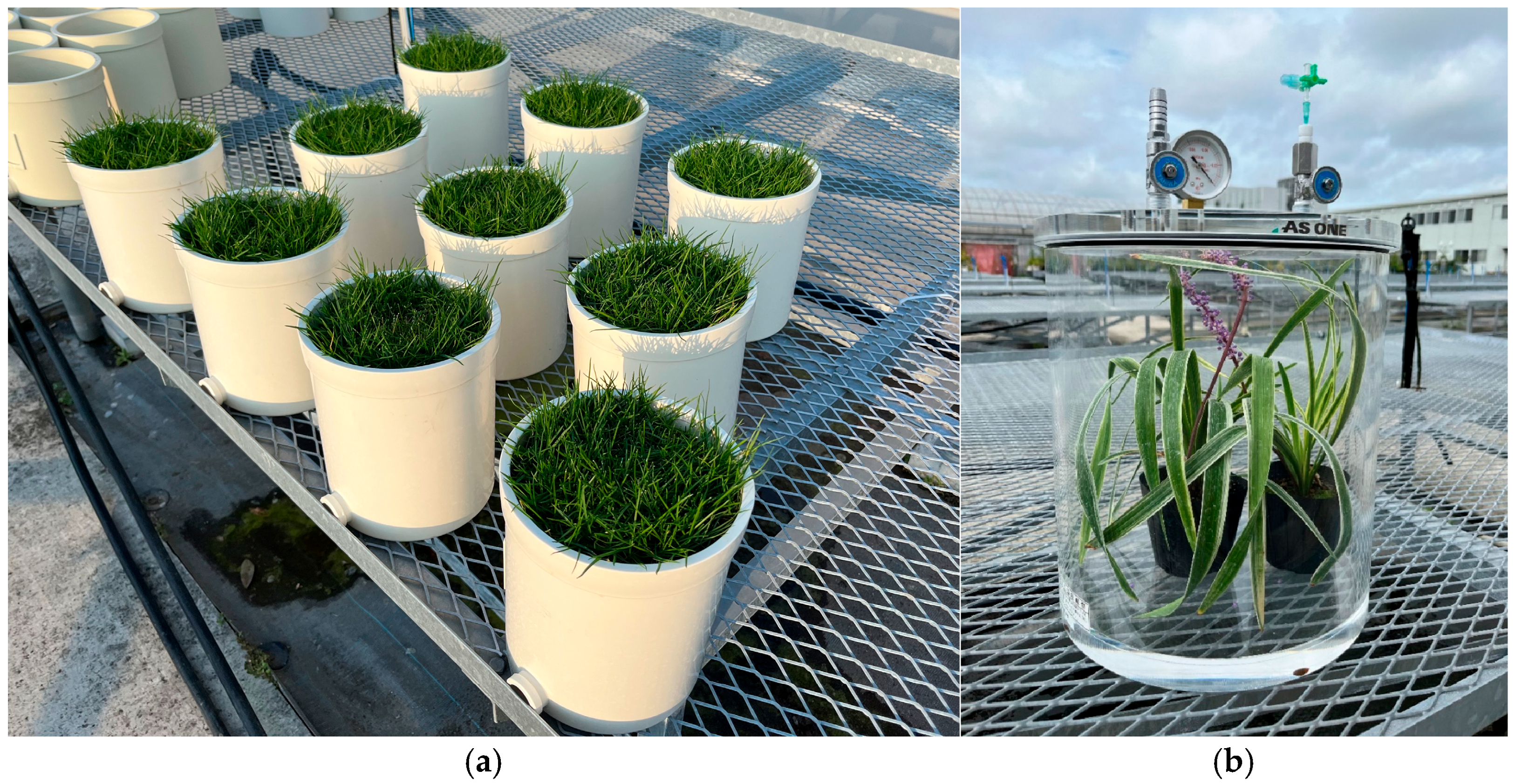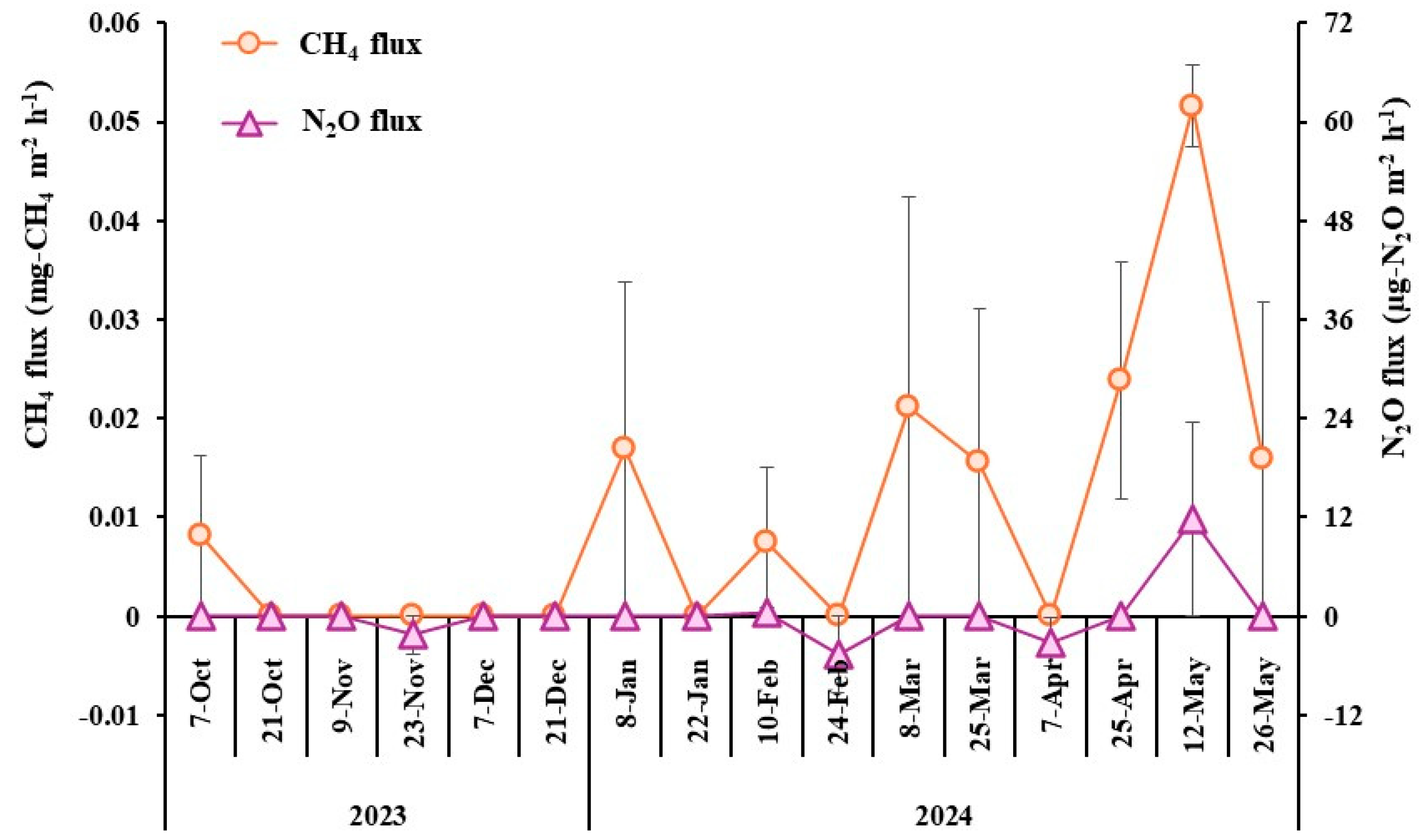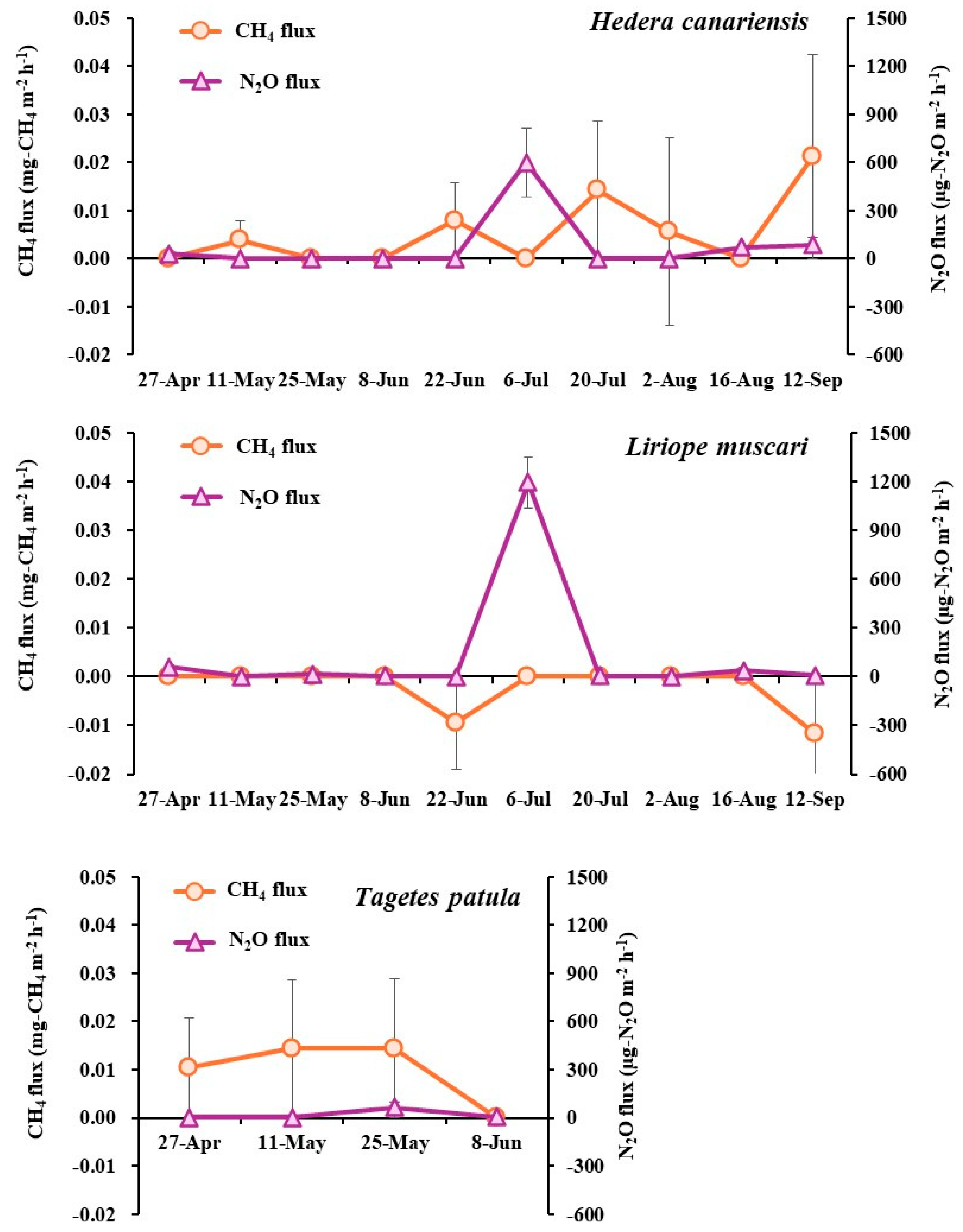Greenhouse Gas Budget Assessment of Production of Kentucky Bluegrass (Poa pratensis) Sod and Three Herbaceous Landscape Plants
Abstract
1. Introduction
2. Materials and Methods
2.1. Experiment 1: GHG Budget Assessment of Kentucky Bluegrass Sod Production
2.2. Experiment 2: GHG Budget Assessments of Potting Production of Three Herbaceous Plants
3. Results
3.1. Experiment 1: GHG Budget Assessment of Kentucky Bluegrass Sod Production
3.1.1. Carbon Sequestration During Sod Production
3.1.2. GHG Fluxes During Sod Production
3.1.3. GHG Emissions from Energy and Resource Consumption During Sod Production
3.1.4. GHG Flux and Carbon Sequestration from Grass Clippings Left As Is
3.2. Experiment 2: GHG Budget Assessments of Potting Production of Three Herbaceous Plants
3.2.1. Carbon Sequestration in Three Herbaceous Plant Potting Productions
3.2.2. GHG Fluxes During Potting Production
3.2.3. GHG Emissions from Energy and Resource Consumption During Potting Production
3.2.4. GHG Budget Assessments of Three Herbaceous Plant Potting Productions
4. Discussion
4.1. GHG Budgets of Kentucky Bluegrass Sod Production
4.2. GHG Budgets of Three Herbaceous Plant Potting Productions
4.3. Toward More Accurate Quantification of GHG Budgets in Horticultural Plant Production
Supplementary Materials
Author Contributions
Funding
Data Availability Statement
Conflicts of Interest
References
- The Intergovernmental Panel on Climate Change (IPCC). Synthesis Report of the IPCC sixth Assessment Report (AR6). 2023. Available online: https://www.ipcc.ch/report/sixth-assessment-report-cycle/ (accessed on 10 August 2025).
- Bisbis, M.B.; Gruda, N.S.; Blanke, M.M. Securing horticulture in a changing climate—A mini review. Horticulturae 2019, 5, 56. [Google Scholar] [CrossRef]
- Gruda, N.; Bisbis, M.; Tanny, J. Influence of climate change on protected cultivation: Impacts and sustainable adaptation strategies-A review. J. Clean. Prod. 2019, 225, 481–495. [Google Scholar] [CrossRef]
- Lee, S.G.; Kim, S.K.; Lee, H.J.; Choi, C.S.; Park, S.T. Impacts of climate change on the growth, morphological and physiological responses, and yield of Kimchi cabbage leaves. Hortic. Environ. Biotech. 2016, 57, 470–477. [Google Scholar] [CrossRef]
- Xu, X. Major challenges facing the commercial horticulture. Frontiers Hortic. 2022, 1, 980159. [Google Scholar] [CrossRef]
- Sangiorgio, D.; Cellini, A.; Donati, I.; Pastore, C.; Onofrietti, C.; Spinelli, F. Facing climate change: Application of microbial biostimulants to mitigate stress in horticultural crops. Agronomy 2020, 10, 794. [Google Scholar] [CrossRef]
- Jain, S.; Lamo, K.; Walling, S.; Imchen, A.; Tirkey, J.F.; Singh, A. Climate-resilient horticulture: Adapting to climate change through innovative practices and technologies. Int. J. Environ. Climate Change 2024, 14, 219–233. [Google Scholar] [CrossRef]
- Gush, M.B.; Blanuša, T.; Chalmin-Pui, L.S.; Griffiths, A.; Larsen, E.K.; Prasad, R.; Redmile-Gordon, M.; Sutcliffe, C. Environmental horticulture for domestic and community gardens—An integrated and applied research approach. Plants People Planet 2024, 6, 254–270. [Google Scholar] [CrossRef]
- Soode, E.; Lampert, P.; Weber-Blaschke, G.; Richter, K. Carbon footprints of the horticultural products strawberries, asparagus, roses and orchids in Germany. J. Clean. Prod. 2015, 87, 168–179. [Google Scholar] [CrossRef]
- Ntinas, G.K.; Neumair, M.; Tsadilas, C.D.; Meyer, J. Carbon footprint and cumulative energy demand of greenhouse and open-field tomato cultivation systems under Southern and Central European climatic conditions. J. Clean. Prod. 2017, 142, 3617–3626. [Google Scholar] [CrossRef]
- Pérez-Neira, D.; Grollmus-Venegas, A. Life-cycle energy assessment and carbon footprint of peri-urban horticulture. A comparative case study of local food systems in Spain. Landsc. Urban Plan. 2018, 172, 60–68. [Google Scholar] [CrossRef]
- Ingram, D.L. Life cycle assessment of a field-grown red maple tree to estimate its carbon footprint components. Int. J. Life Cycle Assess. 2012, 17, 453–462. [Google Scholar] [CrossRef]
- Ingram, D.L. Life cycle assessment to study the carbon footprint of system components for Colorado blue spruce field production and use. J. Ame. Soc. Hortic. Sci. 2013, 138, 3–11. [Google Scholar] [CrossRef]
- Ingram, D.L.; Hall, C.R. Carbon footprint and related production costs of system components of a field-grown Cercis canadensis L.‘Forest Pansy’using life cycle assessment. J. Environ. Hortic. 2013, 31, 169–176. [Google Scholar] [CrossRef]
- Hall, C.R.; Ingram, D.L. Carbon footprint and production costs associated with varying the intensity of production practices during field-grown shrub production. HortScience 2015, 50, 402–407. [Google Scholar] [CrossRef]
- Marble, S.C.; Prior, S.A.; Runion, G.B.; Torbert, H.A.; Gilliam, C.H.; Fain, G.B.; Sibley, J.L.; Knight, P.R. Determining trace gas efflux from container production of woody nursery crops. J. Environ. Hortic. 2012, 30, 118–124. [Google Scholar] [CrossRef]
- Marble, S.C.; Prior, S.A.; Runion, G.B.; Torbert, H.A.; Gilliam, C.H.; Fain, G.B.; Sibley, J.L.; Knight, P.R. Effects of fertilizer placement on trace gas emissions from nursery container production. HortScience 2012, 47, 1056–1062. [Google Scholar] [CrossRef]
- Marble, S.C.; Prior, S.A.; Runion, G.B.; Torbert, H.A.; Gilliam, C.H.; Fain, G.B.; Sibley, J.L.; Knight, P.R. Species and media effects on soil carbon dynamics in the landscape. Sci. Rep. 2016, 6, 25210. [Google Scholar] [CrossRef] [PubMed]
- Kuronuma, T.; Masuda, S.; Mito, T.; Watanabe, H. Inclusive greenhouse gas budget assessment in turfs: From turf production to disposal of grass clippings. J. Environ. Manag. 2023, 346, 118919. [Google Scholar] [CrossRef]
- Minamikawa, K.; Tokida, T.; Sudo, S.; Padre, A.; Yagi, K. Guidelines for Measuring CH4 and N2O Emissions from Rice Paddies by a Manually Operated Closed Chamber Method; National Institute for Agro-Environmental Sciences: Tsukuba, Japan, 2015; Available online: https://www.naro.affrc.go.jp/archive/niaes/techdoc/mirsa_guidelines.pdf (accessed on 10 August 2025).
- Matsumoto, Y.; Yoshida, S.; Nishida, K. Huge Power Consumption by Groundwater Irrigation in Paddy Fields of Volcanic Ash Soils. J. Jpn. Soc. Irrig. Drain. Rural Eng. 2016, 84, 847–850. (In Japanese) [Google Scholar] [CrossRef]
- Seo, Y.; Suzuki, M.; Takagi, T.; Dowaki, K. Life-cycle assessment of adsorbents for biohydrogen production. Resources 2019, 8, 52. [Google Scholar] [CrossRef]
- United States Environmental Protection Agency (USEPA). Emission factor documentation for AP-42 Section 8.17: Perlite processing. Perlite processing. In AP-42, Compilation of Air Pollutant Emission Factors, 5th ed.; Chapter 11: Mineral products industry; USEPA: Washington, DC, USA, 1995; Volume I, 22p. Available online: https://www.epa.gov/sites/default/files/2020-10/documents/b11s30.pdf (accessed on 21 July 2025).
- Barford, C.C.; Wofsy, S.C.; Goulden, M.L.; Munger, J.W.; Pyle, E.H.; Urbanski, S.P.; Hutyra, L.; Saleska, S.R.; Fitzjarrald, D.; Moore, K. Factors controlling long-and short-term sequestration of atmospheric CO2 in a mid-latitude forest. Science 2001, 294, 1688–1691. [Google Scholar] [CrossRef]
- Black, T.A.; Chen, W.J.; Barr, A.G.; Arain, M.A.; Chen, Z.; Nesic, Z.; Hogg, E.H.; Neumann, H.H.; Yang, P.C. Increased carbon sequestration by a boreal deciduous forest in years with a warm spring. Geophys. Res. Lett. 2000, 27, 1271–1274. [Google Scholar] [CrossRef]
- De Vries, W.I.M.; Reinds, G.J.; Gundersen, P.E.R.; Sterba, H. The impact of nitrogen deposition on carbon sequestration in European forests and forest soils. Glob. Change Biol. 2006, 12, 1151–1173. [Google Scholar] [CrossRef]
- Dewar, R.C.; Cannell, M.G. Carbon sequestration in the trees, products and soils of forest plantations: An analysis using UK examples. Tree Physiol. 1992, 11, 49–71. [Google Scholar] [CrossRef] [PubMed]
- Fearnside, P.M.; Guimarães, W.M. Carbon uptake by secondary forests in Brazilian Amazonia. Forest Ecol. Manag. 1996, 80, 35–46. [Google Scholar] [CrossRef]
- Grünzweig, J.M.; Lin, T.; Rotenberg, E.; Schwartz, A.; Yakir, D. Carbon sequestration in arid-land forest. Glob. Change Biol. 2003, 9, 791–799. [Google Scholar] [CrossRef]
- Luyssaert, S.; Schulze, E.D.; Börner, A.; Knohl, A.; Hessenmöller, D.; Law, B.E.; Ciais, P.; Grace, J. Old-growth forests as global carbon sinks. Nature 2008, 455, 213–215. [Google Scholar] [CrossRef]
- Montagnini, F.; Nair, P.K.R. Carbon sequestration: An underexploited environmental benefit of agroforestry systems. Agrofor. Syst. 2004, 61, 281–295. [Google Scholar] [CrossRef]
- Nowak, D.J.; Crane, D.E. Carbon storage and sequestration by urban trees in the USA. Environ. Pollut. 2002, 116, 381–389. [Google Scholar] [CrossRef]
- Marble, S.C.; Prior, S.A.; Runion, G.B.; Torbert, H.A.; Gilliam, C.H.; Fain, G.B. The importance of determining carbon sequestration and greenhouse gas mitigation potential in ornamental horticulture. HortScience 2011, 46, 240–244. [Google Scholar] [CrossRef]
- Favoino, E.; Hogg, D. The potential role of compost in reducing greenhouse gases. Waste Manag. Res. 2008, 26, 61–69. [Google Scholar] [CrossRef]







| Material | Carbon Concentration (%) | Dry Weight (g/pot) | Carbon Content (g/pot) | CO2 Content (t-CO2/ha) | |
|---|---|---|---|---|---|
| Seed | 39.1 ± 0.1 | 0.3 | 0.1 ± 0.0 | 0.215 ± 0.001 | |
| Harvested plants | 34.8 ± 1.5 | 36.6 ± 1.0 | 12.7 ± 0.3 | 23.229 ± 0.534 | |
| CO2 sequestration during sod production | 23.014 | t/CO2/ha | |||
| Three Main Components of the GHG Budgets in Horticulture Plant Production | Values (t-CO2e ha−1 year−1) | |
|---|---|---|
| Photosynthesis | −23.014 | |
| Soil fluxes | CH4 flux | 0.046 |
| N2O flux | 0.003 | |
| GHG emissions from energy and resources use | 5.201 | |
| Total | −17.764 | |
| Material | Dry Weight (g/pot) | Carbon Concentration (%) | Nitrogen Concentration (%) | Carbon Content (g/pot) | CO2 Content (g-CO2/pot) | |
|---|---|---|---|---|---|---|
| Grass clippings at the start of the experiment (6 October 2023) | 50.0 | 41.9 ± 0.1 | 3.5 ± 0.1 | 20.9 ± 0.0 | 76.7 ± 0.2 | |
| Grass clippings at the end of the experiment (7 October 2024) | 7.4 ± 0.9 | 43.1 ± 0.6 | 4.2 ± 0.2 | 3.2 ± 0.4 | 11.8 ± 1.4 | |
| Estimated CO2 re-emission from decomposition of grass clippings | 65.0 | g-CO2/pot | ||||
| Plants | Dry Weight (g/pot) | Carbon Concentration (%) | Carbon Content (g/pot) | CO2 Content (g-CO2/pot) | ||
|---|---|---|---|---|---|---|
| Hedera canariensis | Divided plantlets (27 April 2024) | 0.89 ± 0.08 | 44.2 ± 0.4 | 0.40 ± 0.04 | 1.45 ± 0.14 | |
| Harvested plants (12 September 2024) | 6.31 ± 0.44 | 41.3 ± 0.3 | 2.61 ± 0.18 | 9.56 ± 0.66 | ||
| CO2 sequestration during the potting production | 8.11 | g-CO2/pot | ||||
| Liriope muscari | Divided plantlets (27 April 2024) | 3.10 ± 0.23 | 42.9 ± 0.3 | 1.33 ± 0.10 | 4.88 ± 0.37 | |
| Harvested plants (12 September 2024) | 11.71 ± 0.93 | 37.3 ± 0.7 | 4.33 ± 0.29 | 15.89 ± 1.07 | ||
| CO2 sequestration during the potting production | 11.01 | g-CO2/pot | ||||
| Tagetes patula | Seeds (27 April 2024) | 0.02 ± 0.00 | 48.8 ± 0.2 | 0.01 ± 0.00 | 0.03 ± 0.00 | |
| Harvested plants (8 June 2024) | 2.82 ± 0.07 | 36.4 ± 0.8 | 1.03 ± 0.03 | 3.77 ± 0.12 | ||
| CO2 sequestration during the potting production | 3.74 | g-CO2/pot | ||||
| Plants | Materials | Use (g/pot) | Emission Factor (g-CO2e/g) | Emission (g-CO2e/pot) | Total Emission (g-CO2e/pot) | Percentages of Each Emission to Total | |
|---|---|---|---|---|---|---|---|
| Hedera canariensis | Fertilizer | Solid fertilizer | - | 1.140 | - | 25.1 | - |
| Water-soluble products for liquid fertilizer | 0.875 | 1.649 | 1.443 | 5.7 | |||
| Pesticide | Granules | - | 16.577 | - | - | ||
| Water-soluble products for spraying | 0.01 | 0.166 | 0.7 | ||||
| Potting soil | Kanuma soil | 103.5 | 0.004 | 0.414 | 1.6 | ||
| Perlite | 13.4 | 0.439 | 5.900 | 23.5 | |||
| Compost | 98.2 | 0.077 | 7.593 | 30.3 | |||
| Water | Irrigation | 6500 | 0.00027 | 1.982 | 7.9 | ||
| Dilution water for liquid fertilizer | 875 | ||||||
| Dilution water for pesticide spraying | 10 | ||||||
| Pot | Polypropylene | 3.2 | 2.375 | 7.601 | 30.3 | ||
| Liriope muscari | Fertilizer | Solid fertilizer | - | 1.140 | - | 25.1 | - |
| Water-soluble products for liquid fertilizer | 0.875 | 1.649 | 1.443 | 5.7 | |||
| Pesticide | Granules | - | 16.577 | - | - | ||
| Water-soluble products for spraying | 0.01 | 0.166 | 0.7 | ||||
| Potting soil | Kanuma soil | 103.5 | 0.004 | 0.414 | 1.6 | ||
| Perlite | 13.4 | 0.439 | 5.900 | 23.5 | |||
| Compost | 98.2 | 0.077 | 7.593 | 30.3 | |||
| Water | Irrigation | 6500 | 0.00027 | 1.982 | 7.9 | ||
| Dilution water for liquid fertilizer | 875 | ||||||
| Dilution water for pesticide spraying | 10 | ||||||
| Pot | Polypropylene | 3.2 | 2.375 | 7.601 | 30.3 | ||
| Tagetes patula | Fertilizer | Solid fertilizer | 1.5 | 1.140 | 1.709 | 41.3 | 4.1 |
| Water-soluble products for liquid fertilizer | 0.5 | 1.649 | 0.825 | 2.0 | |||
| Pesticide | Granules | 1 | 16.577 | 16.577 | 40.2 | ||
| Water-soluble products for spraying | 0.01 | 0.166 | 0.4 | ||||
| Potting soil | Kanuma soil | 103.5 | 0.004 | 0.414 | 1.0 | ||
| Perlite | 13.4 | 0.439 | 5.900 | 14.3 | |||
| Compost | 98.2 | 0.077 | 7.593 | 18.4 | |||
| Water | Irrigation | 1250 | 0.00027 | 0.472 | 1.1 | ||
| Dilution water for liquid fertilizer | 500 | ||||||
| Dilution water for pesticide spraying | 10 | ||||||
| Pot | Polypropylene | 3.2 | 2.375 | 7.601 | 18.4 | ||
Disclaimer/Publisher’s Note: The statements, opinions and data contained in all publications are solely those of the individual author(s) and contributor(s) and not of MDPI and/or the editor(s). MDPI and/or the editor(s) disclaim responsibility for any injury to people or property resulting from any ideas, methods, instructions or products referred to in the content. |
© 2025 by the authors. Licensee MDPI, Basel, Switzerland. This article is an open access article distributed under the terms and conditions of the Creative Commons Attribution (CC BY) license (https://creativecommons.org/licenses/by/4.0/).
Share and Cite
Kuronuma, T.; Watanabe, H.; Masuda, S.; Mito, T. Greenhouse Gas Budget Assessment of Production of Kentucky Bluegrass (Poa pratensis) Sod and Three Herbaceous Landscape Plants. Horticulturae 2025, 11, 1132. https://doi.org/10.3390/horticulturae11091132
Kuronuma T, Watanabe H, Masuda S, Mito T. Greenhouse Gas Budget Assessment of Production of Kentucky Bluegrass (Poa pratensis) Sod and Three Herbaceous Landscape Plants. Horticulturae. 2025; 11(9):1132. https://doi.org/10.3390/horticulturae11091132
Chicago/Turabian StyleKuronuma, Takanori, Hitoshi Watanabe, Shohei Masuda, and Takuya Mito. 2025. "Greenhouse Gas Budget Assessment of Production of Kentucky Bluegrass (Poa pratensis) Sod and Three Herbaceous Landscape Plants" Horticulturae 11, no. 9: 1132. https://doi.org/10.3390/horticulturae11091132
APA StyleKuronuma, T., Watanabe, H., Masuda, S., & Mito, T. (2025). Greenhouse Gas Budget Assessment of Production of Kentucky Bluegrass (Poa pratensis) Sod and Three Herbaceous Landscape Plants. Horticulturae, 11(9), 1132. https://doi.org/10.3390/horticulturae11091132





